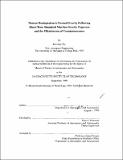Human readaptation to normal gravity following short-term simulated Martian gravity exposure and the effectiveness of countermeasures
Author(s)
Wu, Rex Hay, 1973-
DownloadFull printable version (17.07Mb)
Other Contributors
Massachusetts Institute of Technology. Dept. of Aeronautics and Astronautics.
Advisor
Dava J. Newman.
Terms of use
Metadata
Show full item recordAbstract
Postural instability is a main problem astronauts face upon return to Earth following space flights. The causes of postural instability include orthostatic intolerance, modified vestibular functions, and altered muscle gains. This thesis investigates the modifications in human walking gait following exposure to simulated Martian gravity by examining the ground reaction force, muscle electromyogram, and joint kinematics of the lower body extremities. The "Moonwalker II" simulator, designed and developed with features such as modularity, stability, and versatility, closely simulates a partial gravity environment on the lower extremities. An experiment utilizing the Moonwalker II is designed to test three hypotheses including (1) a partial gravity simulator utilizing suspension technique is effective in inducing the heavy legs phenomena characterized by lower than normal muscle gain, (2) the changes in human walking gait following partial gravity simulation can be found in ground reaction force, muscle activation, and joint kinematics, and (3) exercise can enhance readaptation to Earth gravity following partial gravity exposure. Twelve healthy subjects are tested before and after Martian gravity simulation to determine the effects of partial gravity adaptation on walking performance. The effect of countermeasure (i.e., jumping with extra weight) on human walking gait readaptation post simulation is also tested. The measurements chosen for analysis include ground reaction force first and second peaks, electromyogram integrated linear envelope, maximum joint angle amplitudes, and phase plane data. An increased ground reaction peak amplitudes (first and second peaks), reduced muscle activities in three of the four muscles (biceps femoris, tibialis anterior, and gastrocnemius), and increased joint maximum angles are found after the Martian gravity simulation (p <0.05). In addition, jumping with extra weights is effective in reducing the walking gait deviation from the baseline 1G condition. These results suggest that after the simulated partial gravity exposure, the subjects walk with an altered gait that features an increased downward center of mass acceleration, reduced muscle activity, and increased maximum joint angles.
Description
Thesis (S.M.)--Massachusetts Institute of Technology, Dept. of Aeronautics and Astronautics, 1999. Includes bibliographical references (p. 157-160).
Date issued
1999Department
Massachusetts Institute of Technology. Department of Aeronautics and AstronauticsPublisher
Massachusetts Institute of Technology
Keywords
Aeronautics and Astronautics.